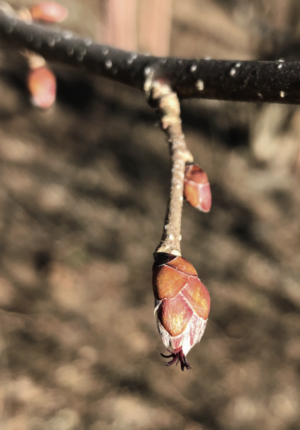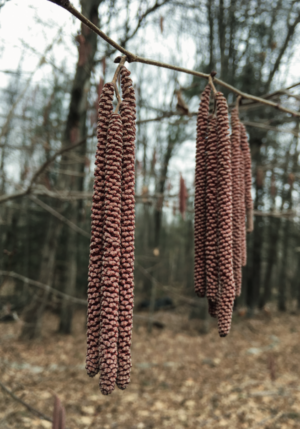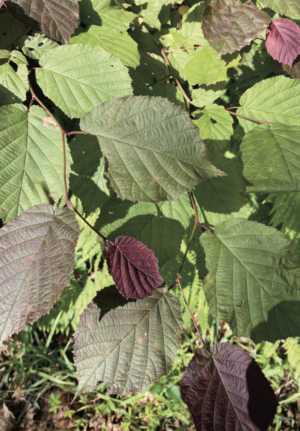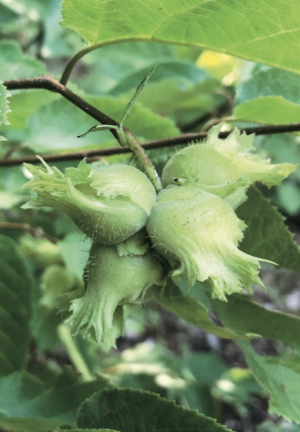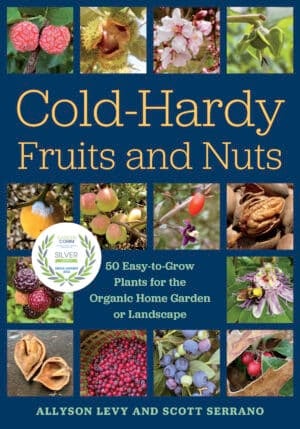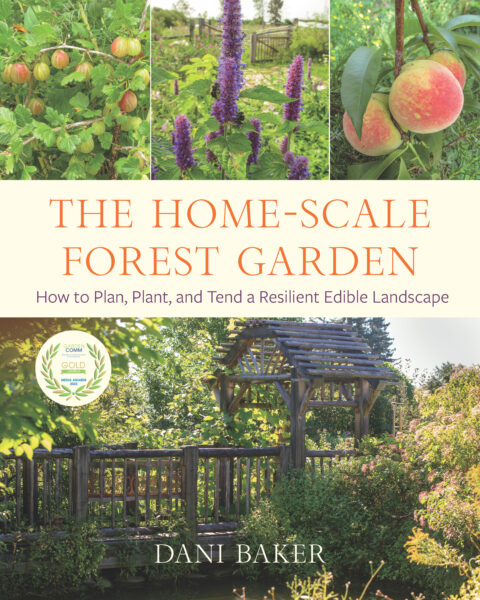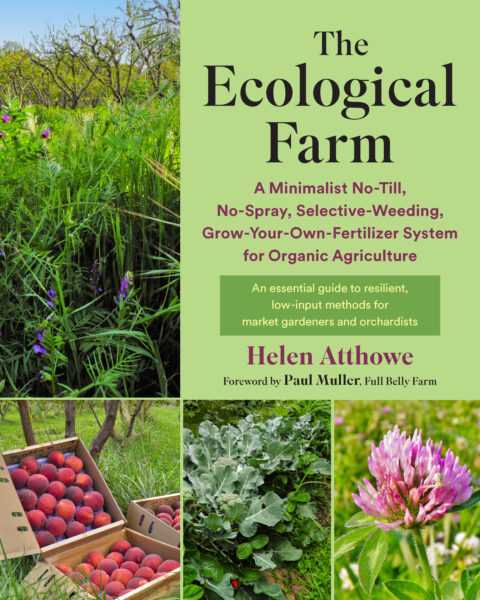A Guide to Harvesting Hazelnuts
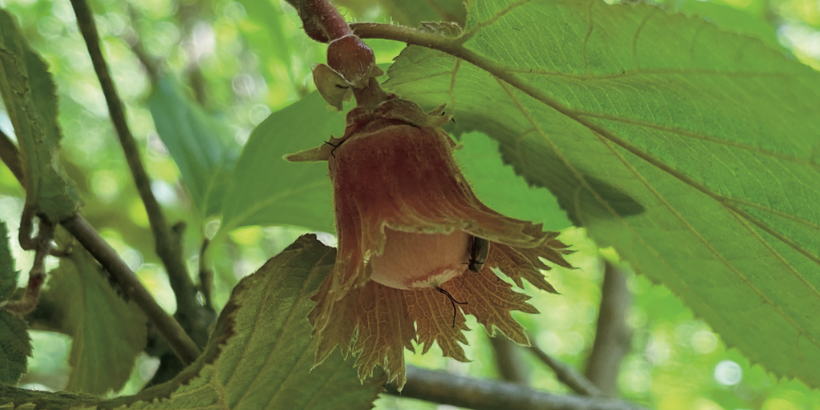
Today, hazelnuts are all the rage. These small nuts, known for their one-of-a-kind flavor, are both delicious AND hearty enough to be grown and harvested in almost any weather conditions. So what are you waiting for? It’s time to start harvesting hazelnuts!
The following is an excerpt from Cold-Hardy Fruits and Nuts by Scott Serrano and Allyson Levy. It has been adapted for the web.
“Hazels belong to a very ancient family, and some of the fossil hazel leaves are hardly to be distinguished from those species which are living today.” — Robert T. Morris, 19211
The History of Hazelnuts
Corylus americana, C. avellana American Hazelnut, European Hazelnut, Filbert
The Latin name Corylus is derived from the Greek word korys, which means “helmet” or “hood,” in reference to the fleshy husk that completely covers each nut.2 There is a long history of people using hazelnuts as a nutritious food crop in addition to the nut being an important forage for wildlife.
The name cobnuts refers to larger cultivated varieties of hazels, and filberts is often used as the name for European hazelnuts grown in the Pacific Northwest. But in truth, the word filbert was a corruption of full beard, which specifically refers to a hazel whose husk extended past the nut.3
How to Grow and Harvest Hazelnuts
European hazelnut (C. avellana) is indigenous to Europe and the United Kingdom, and is the main source for the majority of improved cultivars. Although there are tree forms of the hazelnut, the common form is a dense, multi-stemmed shrub that sends up new shoots every year.
Because of its typical form of growth, there is a long tradition of hazelnuts being planted as a multifunctional hedgerow that is not only used as a food source but also is regularly pruned to create a sustainable supply of wood for fires and basket making, as well as providing a protective windbreak around farm fields.
The dominant species of hazelnut native to the United States is the American hazelnut (C. americana).
Growth Difficulty Rating: 1
Both American and European hazelnuts are easy to grow, but the latter can be susceptible to EFB, or eastern filbert blight.
Taste Profile and Uses
The nuts are covered by an involucre (protective husk), which is fleshy as well as decorative. As the nuts ripen through the summer, this involucre expands until the nut is ripe and falls from the husk, which sometimes remains on the tree branch. The nut size varies from 1⁄2 inch (1.3 cm) in most wild species to 1 inch (2.5 cm) in bred cultivars. The thickness of the shells varies with each species and cultivar, but they’re generally easy to open with a nut cracker.
Hazelnuts are a nutritious nut, with a mild sweet-buttery flavor that we think tastes delicious eaten out of hand, but roasting the nuts brings out their best culinary qualities and they are often used this way as an addition to both savory and sweet recipes. One of the most popular products made from this nut is Nutella, the famous chocolate hazelnut spread.
Plant Description: Hazelnuts
A moderately fast-growing, deciduous, multi-suckering shrub or tree that can reach 8 feet (2.4 m) (American) to 20 feet (6.1 m) (European) in height, depending on the species and cultivar. Both species have bright green foliage that has an attractive pleated appearance with toothed edges. The leaves are alternately arranged on the stem.
The 2- to 4-inch (5.1–10.2 cm) European leaves are more ovate, while the American are 21⁄2 to 6 inches (6.4–15.2 cm) long, with a narrower shape and pointed tip. As the plants get older, the root sections send out new suckers in a circle surrounding the bush, sometimes appearing a little untidy and messy.
Hazelnut Flowers
Hazelnuts have both male and female flowers on the same plant, with very attractive catkins (male flowers) that bloom to a length of 2 to 4 inches (5.1–10.2 cm) in the American species and 2 to 5 inches (5.1–12.7 cm) for the European types.
Both the American and European hazelnuts produce yellow catkins, while purple-leaved cultivars produce light pink catkins.
The catkins for both types develop in the late summer and are displayed all winter long on the deciduous branches, creating a highly ornamental effect, with the long flowers opening up into handsome tassels in early spring.
Shortly after this the tiny scarlet-red female flowers for both species open near the end of the branch stems and grow to about 1⁄8 inch (3 mm).
Pollination Requirements for Hazelnuts
The flowers open in early spring when few insects are alive, so hazelnuts depend on wind to be pollinated. Bushes are not self-fertile and must have another hazel bush to cross-pollinate them to produce nuts.
They benefit from being planted in groups, and American and European species will cross-pollinate each other, which can provide an opportunity to try growing different types of hazels. There are several new cultivars that open at slightly different times and may have specific pollination requirements.
Site and Soil Conditions
Both plant species are widely adaptable to different growing conditions but are best grown in slightly acidic soil in part shade, or in consistently moist soil in full sun. Hazel bushes do less well in sandy soils, but adding leaf humus, compost, or other organic materials will help the plant’s roots adapt.
American hazelnut is found in our region of upstate New York in forest clearings and along the alluvial clay soil banks of streams, as long as they are not waterlogged, whereas European types prefer organically rich, well-drained soil.
Hardiness of Hazelnuts
American and European plants are hardy to about zone 4, or −30°F (−34°C), but different cultivars have various levels of cold tolerance.
Fertilization and Growth
Underlining the plant’s toughness, hazel bushes produce edible nuts in the wild in bad soil with little fertility. But plants will be more productive with regular additions of compost applied as a mulch.
Hazelnut Cultivars
Since the early 1900s, efforts to develop suitable hazelnut cultivars for eastern North America have been ongoing, with the goal to combine the disease resistance and winter hardiness from cold-climate-adapted species with the larger kernels and the thin- ner shells of European hazels.4
The two primary sources for hazelnut breeding have been American and European hazelnuts, which have been combined and crossed with other hazel species to produce close to one hundred cultivars.5
Recommended Cultivars
Below we list a few of the most recommended cultivars that we have found produce reliable crops. In the last fifty years, the big push in breeding has been to increase nut yields and build immunity from EFB in order to create disease-resistant nuts. So in the near future, there should be many new blight-resistant hazelnuts on the market.6
It should be noted that because of the danger of EFB, mail-order nurseries will not ship hazelnuts to certain parts of the United States.
American Hazelnut: ‘Winkler’: An American cultivar introduced in 1918 that grows to 6 feet (1.8 m) and is not susceptible to EFB, with nuts that are slightly larger than straight species.
European Hazelnut: ‘Rote Zeller’: An ornamental purple-leafed cultivar from Germany that is hardy to zone 5 (−20°F/−29°C). The plants begin each season with scarlet-burgundy leaves that turn green by the middle of summer. They yield medium-sized nuts covered with attractive scarlet husks.
Hybrids:
- ‘McDonald’: A large bush that has good EFB resistance and was introduced by the plant breeder Peter McDonald. It has good-quality nuts and is hardy to zone 4 (−30°F/−34°C).
- ‘Slate’: A blight-resistant (possibly immune), productive cultivar with very large and flavorful nuts. Introduced by George Slate of the New York Agricultural Experiment Station in Geneva, New York, the plants reach 12 to 18 feet (3.7–5.5 m) in height.
Related Species to Hazelnuts
The beaked or Western hazelnut (C. cornuta) is a bush native to large portions of North America from Maine to British Columbia. A drought-resistant, 4- to 9-foot (1.2–3 m) tall bush, though it can grow larger.
Hazelnut Propagation
Nuts can be gathered in late summer (before squirrels get them) and planted in a pot over the winter in a protected site that rodents cannot find. A traditional way to get plants that are true to the original cultivars is by digging up and replanting some of the new shoot suckers that form around the base of the bush, which is best done in early spring.
Another way to propagate hazels is by layering branches: Bury low-lying branches in the soil to allow them to form roots. Roots may take more than one season to develop, and you can leave buried limbs in place for years before digging them up so that you get plants with substantial root systems.
Special Note on Hazelnuts
Grafting is another method of producing cultivars. The chief problem with a grafted hazelnut is its propensity for sucker- ing, and if these suckers are not pruned away from the tree, the resulting shoots will not be true to the specific cultivar. For this reason we recommend planting only bushes that have their own roots and are not grafted.
Special Pruning Considerations
As hazelnut branches age they will eventually stop yielding nuts. This means that older, less productive branches should be pruned off the bush in favor of younger ones that will replace them.
Since nut productivity on branches lasts from five to ten years, look for branches that have stopped producing catkins to determine which should be pruned off. These are coppiced (cut back to the ground periodically to stimulate new growth). Many specimens of hazel have lived for hundreds of years in Europe.7
Pests & Problems
The chief limiting factor to growing hazelnuts in the United States has been eastern filbert blight (EFB). This disease is a naturally occurring fungus, native to the eastern portion of the United States and a few sites in the West. Many university and USDA breeding programs have been dedicated to producing disease-resistant cultivars.8
EFB is the major problem with European hazelnuts. The blight (Anisogramma anomala) has evolved alongside American hazelnuts and does not affect this species.
European hazelnuts were introduced into the United States as a commercial crop in the early twentieth century, and shortly thereafter entire East Coast orchards were destroyed. EFB was found in various states east of the Rocky Mountains, and in the 1970s it was discovered in orchards in Oregon.
Preventing Pest Damage
EFB appears as oval cankers that grow in rows on branches; by summer, girdled branches become obvious because dead leaves remain attached. Over a short span of time, more leafless, dead, and dying branches become visible in the canopy as the disease spreads.
Diligently pruning out infected branches and applying a fungicide will help to reduce the disease in an affected area. Dispose of diseased branches by burning them or placing them in the garbage. If EFB is a major problem in your region, selecting disease-resistant cultivars will be crucial to reducing the risk of the blight.
In our gardens the ten hazelnut bushes of different species and disease-resistance levels have been growing for over eighteen years and we have not had any problems with the blight. However, we do live in a part of the United States where EFB is present, and we are always on the lookout for signs of the disease.
Notes
1. Robert T. Morris, Nut Growing (New York: Macmillan, 1921), 203.
2. Susanna Lyle, Fruit & Nuts (Portland: Timber Press), 2006.
3. Morris, Nut Growing, 210.
4. Thomas Molnar, “Corylus” Wild Crop Relatives, edited by Chittaranjan Kole (New Brunswick, NJ: Rutgers University, 2011), 15–48, www.researchgate.net/publication/226038600_Corylus.
5. Molnar, “Corylus,” 15–48.
6. P. Rutter, S. Wiegrefe, and B. Rutter-Daywarer, Growing Hybrid Hazelnuts (White River Junction, VT: Chelsea Green, 2015).
7. Ralph Harmer, “Restoration of Neglected Hazel Coppice,” Edinburgh Forestry Commission (2004), https://www.forestresearch.gov.uk/documents/6757/FCIN056.pdf.
8. JasonFischbachandLoisBraun,“AProduction and Economic Model for Hedgerow Hazelnut Production in the Midwestern United States” (2017), https://www .midwesthazelnuts.org/uploads/3/8/3/5 /38359971/production_and_economic _model_for_hedgerow_hazelnut_production _v4.pdf; C. F. Lunde, S. A. Mehlenbacher, and D. C. Smith, “Survey of Hazelnut Culti- vars for Response to Eastern Filbert Blight Inoculation,” HortScience 35, no. 4 (July 2000), 729–31; J. Julian, C. Seavert, and J. L. Olsen, “An Economic Evaluation of the Impact of Eastern Filbert Blight Resis- tant Hazelnut Cultivars in Oregon, USA” Acta Horticulturae 845 (2009), 725–32.
Recommended Reads
Recent Articles
Garden strawberries are excellent for both covering the ground and for growing fruit. If you’re planning out a forest garden, or are just looking for a plant to use as ground cover, strawberries are a great option. The following is an excerpt from The Home-Scale Forest Garden by Dani Baker. It has been adapted for…
Read MoreAsparagus is a delicious vegetable with a layered history. How did this aspiring spear make its way from growing in the wild to appearing on our plates? The following is an excerpt from the The Seed Detective by Adam Alexander. It has been adapted for the web. “Nature gives us the key to every secret…
Read MoreInterested in growing trees? Here are some tips on successfully planting, transplanting, and pruning trees to create a flourishing forest garden! The following is an excerpt from The Home-Scale Forest Garden by Dani Baker. It has been adapted for the web. Planting Potted Trees and Shrubs If you order potted trees, check with your supplier to…
Read MoreWith the right strategies and practices, composting on a small farm is surprisingly easy and inexpensive. Just follow these steps for making compost, and your farm will be thriving in no time! The following excerpt is from The Lean Farm Guide to Growing Vegetables by Ben Hartman. It has been adapted for the web. (All photographs by Ben…
Read MoreGarlic mustard: while known as “invasive,” this plant can be consumed in its entirety and has great nutritional value. Plus, the garlic-flavor is a perfect addition to any recipe that calls for mustard! The following are excerpts from Beyond the War on Invasive Species by Tao Orion and The Wild Wisdom of Weeds by Katrina…
Read More

